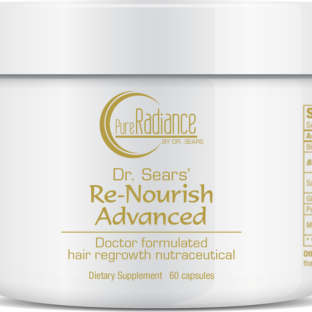Women are living longer today than ever before. That’s the good news. But here’s the catch.
You still go through menopause at about the same age. Perimenopause can start as early as your 35th birthday.
And when menopause hits at around 50, your estrogen levels can drop by as much as 60%.
So with a longer life expectancy, you simply live more years in an estrogen-deprived state. And that’s no fun.
Low estrogen also takes a toll on your skin. It makes you look and feel older than you really are.
But you can reverse sagging, wrinkling, thinning and dry skin. And I’m not talking about Botox or plastic surgery.
The secret is to reverse your low estrogen levels. You see, your skin needs estrogen just as much as the rest of your body does.
In fact, your skin is FULL of estrogen receptors…
Estrogen helps build the collagen and elastin network that supports your skin. When estrogen levels drop, so does collagen production. Your skin thins out. It loses its elasticity. And you start seeing wrinkles in the mirror.
Low estrogen also dries out your skin. That’s because estrogen increases hyaluronic acid, your skin’s natural moisturizer. Estrogen helps maintain fluid balance and keeps your skin plump and hydrated.1
In other words, your skin literally withers without enough estrogen.
I see it all the time in my patients here at the Wellness Center. Their skin lets me know where their estrogen levels are.
And research backs up what I’ve observed over the years. Studies show a strong link between skin collagen loss and estrogen deficiency.2
But when women get more estrogen, it increases the collagen content, thickness and elasticity of their skin. It also decreases dry skin.3
In one study of 3,875 postmenopausal women, those who used estrogen were 24% less likely to have dry skin. And they were 33% less likely to have wrinkles.4
And you don’t need to take hormone replacement therapy (HRT) to get the benefits. A study by Austrian researchers tested what happens when you apply different kinds of estrogen directly to the skin.
Before I tell you what happened, let me back up a little.
You see, there isn’t just one estrogen hormone. Estrogens are a group of three similar hormones.
Estradiol is the most abundant form and also the strongest. Estriol is the primary estrogen produced during pregnancy. And estrone is the weakest estrogen, which is produced during menopause.
In the Austrian study, the researchers tested creams containing either estradiol or estriol. They applied them to the skin of 59 perimenopausal women who were already showing signs of aging.
After six months, the results for both creams were amazing:
- Collagen increased significantly;
- Elasticity and firmness of the skin markedly improved;
- Wrinkle depth and pore sizes decreased by 61% to 100%;
- skin moisture increased.
And here’s what was really interesting. The researchers found that estriol was even more effective than estradiol. It’s the opposite of what you might expect. Let me explain.
Estradiol is the strongest estrogen when you take it orally. Estriol is considered much weaker. But when it was applied to skin, estriol has mch more potent anti-aging effects.5
I often recommend topical estriol to my patients. It helps help turn dry, thinning, wrinkled skin into smoother, fresher and younger-looking skin.
And it’s safe. In a review of 45 studies published in Alternative Medicine
Review,6 estriol was found to be an effective and safe treatment with fewer side effects than HRT.
And, importantly, when it’s applied to skin it doesn’t get into the bloodstream to disrupt overall hormone balance.7
You don’t need a prescription for estriol cream. You can find it on the Internet or at your health food store. Just apply a quarter teaspoon to your face and neck twice a day.
But make sure the cream contains “USP” estriol. That means it meets the standards of the United States Pharmacopeia. The USP is a scientific nonprofit that sets quality standards for medicines, dietary supplements, and foods.
And as with anything else you put on your skin, make sure your estriol cream contains no paraben preservatives, mineral oil or petroleum products.
And there is just one caveat. Estriol is the safest estrogen you can use. But if you’ve been diagnosed with any condition involving sensitivity to estrogen, like endometriosis, uterine fibroids, or breast, uterine, or ovarian cancer, you’ll want to talk to your doctor about using it.
To Your Good Health,
Al Sears, MD
1. Verdier-Sévrain, S., et al. (2006), “Biology of estrogens in skin: implications for skin aging.” Experimental Dermatology 2006;15: 83–94.
2. Calleja-Agius J, Muscat-Baron Y, Brincat MP. “Skin ageing.” Menopause Int. 2007;13(2):60-4.
3. Patriarca MT, Goldman KZ, Dos Santos JM, et al. “Effects of topical estradiol on the facial skin collagen of
postmenopausal women under oral hormone therapy: a pilot study.” Eur J Obstet Gynecol Reprod Biol. 2007;130(2):202-5.
4. Laura B. Dunn et al, “Does Estrogen Prevent Skin Aging? Results From the First National Health and Nutrition Examination Survey (NHANES I).” Arch Dermatol. 1997;133:339-342.
5. Schmidt JB, Binder M, Demschik G, Bieglmayer C, Reiner A., “Treatment of skin aging with topical estrogens.” Int J Dermatol. 1996;35(9): 669-74.
6. Head, KA. “Estriol: Safety and efficacy.” Altern Med Rev. 1998;3(2):101-13.
7. Kainz C, Gitsch G, Stani J, Breitenecker G, Binder M, Schmidt JB. ‘When applied to facial skin, does estrogen
ointment have systemic effects?” Arch Gynecol Obstet. 1993;253(2):71-4.








